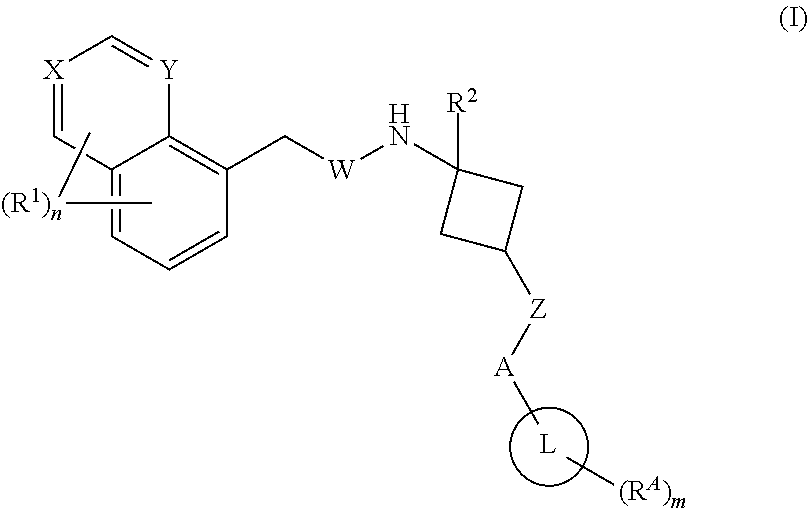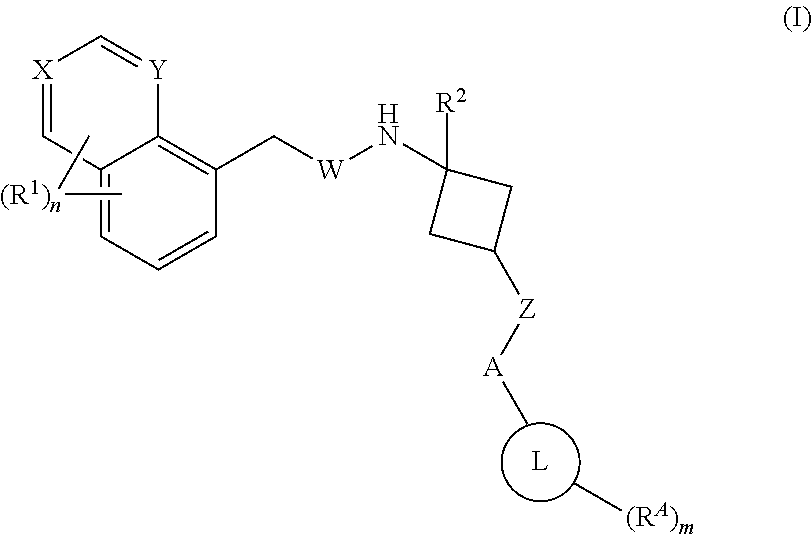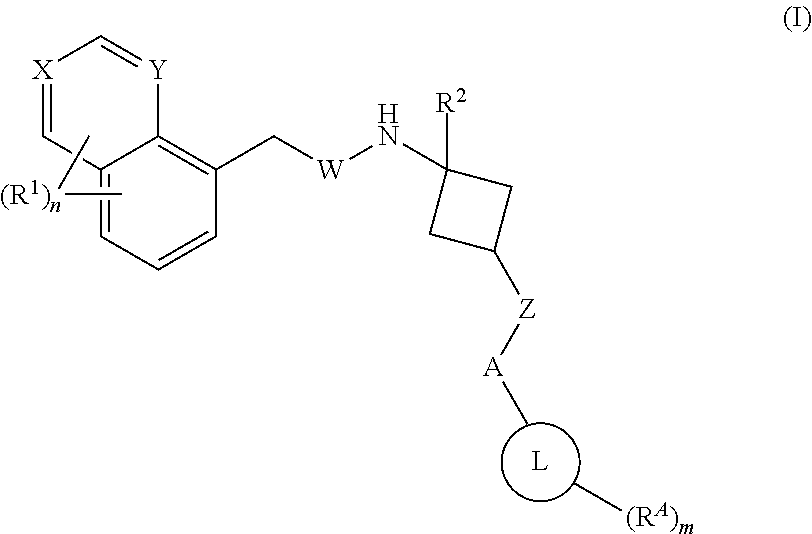1,3-substituted cyclobutyl derivatives and uses thereof
a technology of cyclobutyl derivatives and derivatives, which is applied in the field of 1,3-substituted cyclobutyl derivatives, can solve the problems of pain and inflammation, patients suffering from ocular surface pain, and chronic ocular surface pain, and achieve the effect of reducing the number of patients and improving the quality of li
- Summary
- Abstract
- Description
- Claims
- Application Information
AI Technical Summary
Benefits of technology
Problems solved by technology
Method used
Image
Examples
example 1
of (1r,3r)-3-(4-fluoro-3-(trifluoromethyl)phenoxy)-N-((6-methylisoquinolin-5-yl)methyl)cyclobutan-1-amine, HCl
Step 1.1: Synthesis of 6-methylisoquinoline-5-carbaldehyde
[0603]
[0604]To the solution of 5-bromo-6-methylisoquinoline [CAS No. 1146298-61-4] (0.4 g, 1.80 mmol) in dry THF (10 mL), n-BuLi (2.5M in THF) (1.1 mL, 2.70 mmol) was added dropwise at −78° C. and stirred for 30 min under argon atmosphere. DMF (0.27 mL, 3.60 mmol) was added dropwise at −78° C., temperature was raised to rt gradually and stirred for 1 h. Reaction mixture was quenched with 10% NH4Cl solution and extracted with EtOAc 3×'s. The combined organic portion was washed with brine solution, dried over anhydrous Na2SO4, filtered and concentrated in vacuo to yield the crude product. The crude was purified by flash chromatography (12 g SiliCycle column, 0-50% EtOAc in Hexane elution) to provide 6-methylisoquinoline-5-carbaldehyde (0.16 g, 52%). MS (ESI+) [Method 1A]: m / z 172.0 (M+H); Rt 0.14 min. 1H NMR (400 MHz, C...
example 2
of (1r,3r)-N-((6-methylisoquinolin-5-yl)methyl)-3-((6-(trifluoromethyl)pyridin-3-yl)oxy)cyclobutan-1-amine, HCl
Step 2.1: Synthesis of tert-butyl ((1r,3r)-3-((6-(trifluoromethyl)pyridin-3-yl)oxy)cyclobutyl)carbamate
[0611]
[0612]To the solution of tert-butyl ((1s,3s)-3-hydroxycyclobutyl)carbamate (200 mg, 1.07 mmol) in THF (5 mL), 6-(trifluoromethyl)pyridin-3-ol [CAS No. 216766-12-0] (191 mg, 1.17 mmol), PPh3 (420 mg, 1.60 mmol) and diisopropyl azodicarboxylate (0.25 mL, 1.60 mmol) were added at rt. The reaction mixture was stirred at 50° C. for 16 h under N2 atmosphere. Reaction mixture was diluted with water and extracted 3× with EtOAc. The combined organic portion was washed with brine solution, dried over anhydrous Na2SO4, filtered and concentrated in vacuo. The residue was purified by flash chromatography (12 g SiliCycle column, 0-20% EtOAc in Hexane elution) to provide tert-butyl ((1r,3r)-3-((6-(trifluoromethyl)pyridin-3-yl)oxy)cyclobutyl)carbamate (300 mg, 71%). 1H NMR (300 MHz,...
example 3
of (1r,3r)-3-(4-fluoro-3-(trifluoromethyl)phenoxy)-N-((6-fluoroisoquinolin-5-yl)methyl)cyclobutan-1-amine, HCl
Step 3.1: Synthesis of 6-fluoroisoquinoline-5-carbaldehyde
[0617]
[0618]To the solution of 6-fluoroisoquinoline [CAS No. 1075-11-2] (0.4 g, 2.72 mmol) in anhydrous THF (10 mL), LDA (2M in THF) (2.04 mL, 4.08 mmol) was added dropwise at −78° C. and stirred for 2.5 h under N2 atmosphere. Piperidine-1-carbaldehyde [CAS No. 2591-86-8] (0.92 g, 8.15 mmol) dissolved in THF (5 mL) was added dropwise at −78° C. over a period of 0.5 h and stirred for 1 h, while temperature was raised slowly to 0° C. Then the reaction was quenched with saturated NH4Cl solution and extracted with EtOAc twice. The combined organic portion was washed with brine, dried over anhydrous Na2SO4, filtered and concentrated in vacuo to yield the crude product. The crude was purified by flash chromatography (12 g SiliCycle column, 0-20% EtOAc in Hexane elution) to provide 6-fluoroisoquinoline-5-carbaldehyde (0.17 g...
PUM
 Login to View More
Login to View More Abstract
Description
Claims
Application Information
 Login to View More
Login to View More - R&D
- Intellectual Property
- Life Sciences
- Materials
- Tech Scout
- Unparalleled Data Quality
- Higher Quality Content
- 60% Fewer Hallucinations
Browse by: Latest US Patents, China's latest patents, Technical Efficacy Thesaurus, Application Domain, Technology Topic, Popular Technical Reports.
© 2025 PatSnap. All rights reserved.Legal|Privacy policy|Modern Slavery Act Transparency Statement|Sitemap|About US| Contact US: help@patsnap.com



